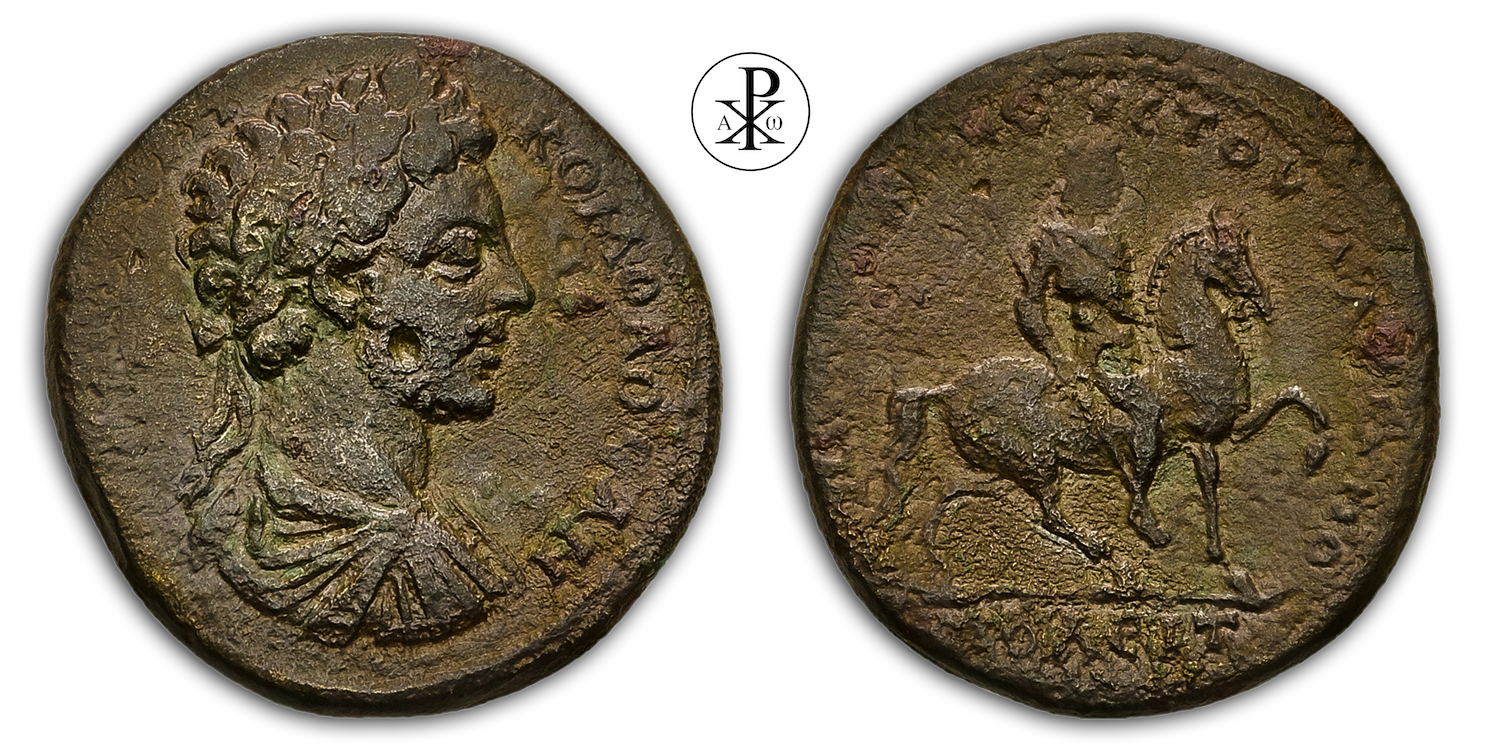Imperator Caesar Lucius Aelius Aurelius Commodus Augustus Pius Felix
Reign: Commodus, under Lucius Aemilius Iustus (legatus Augusti pro praetore)
Mint: Hadrianopolis, Thrace
Date: 191/192 AD
Nominal: Bronze
Material: AE
Diameter: 27.5mm
Weight: 13.09g
Reference: RPC IV.1 25059 (this coin)
Reference: Jurukova 116
RPC Online: https://rpc.ashmus.ox.ac.uk/coins/4/25059
Rare: Specimens 1 (0 in the core collections)
Provenance: Concordia Numismatik Tumeltsham, Austria (Auction 5, Lot 386)
Pedigree: –
Special: RPC Online Plate coin
Obverse: Laureate head of Commodus, right
Inscription: ΑVΤ ΚΑΙ Λ ΑVΡΗ ΚΟΜΟΔΟϹ ΑΝ
Translation: Autokrator Kaisaros Lucios Aurelios Komodos Antoninos
Translation: Imperator Caesar Lucius Aurelius Commodus Antoninus
Reverse: Emperor on horseback, right, holding sceptre
Inscription: ΗΓ ΑΙΜΙΛ ΙΟVϹΤΟV ΑΔΡΙΑΝΟΠΟΛΕΙΤ
Translation: Hegemon Aimilios Ioustous Adrianopoleiton
Translation: Legatus Augusti pro praetore Aemilius Iustus, City of Hadrianopolis
Comment: Hadrianopolis, or Adrianople, is known today as Edirne. With just under 170,000 inhabitants, today’s city is the westernmost large city in Turkey. It is located in the Bulgarian-Greek-Turkish border triangle, in Eastern Thrace, the European part of Turkey. At the same time, it is also the centre of the central county (Merkez). Edirne was for a time the capital of the Ottoman Empire and is today the administrative centre of the province of the same name. In its history, it bore the names Odrysai (Thracian), Orestia (ancient Greek) and, as mentioned, Hadrianopolis (Latin, city of Hadrian). Edirne is an ancient city, the first settlements are said to have existed as early as the 5th millennium BC. The city has had various names in its history. In its pre-Roman times, it was known as Odrysia, probably in reference to the Thracian tribe of Odrysians, or Uscudama, and belonged to Thrace. Odrysia was the capital of the Odrysian Empire from the 5th to the 3rd century BC. Between 171 BC and 168 BC, the area was occupied by the Romans. During his reign, Augustus renounced the conquest of Thrace and thus also of the city. Thrace was not conquered until the reign of Emperor Claudius. Hadrian ordered the city to be rebuilt and expanded around 125 AD and gave it the name Hadrianopolis (City of Hadrian). In 378 AD, the Romans under Emperor Valens were defeated there by the Goths (Battle of Adrianople). In 395 AD, the city became the centre of the Roman province of Haemimontus. The city was the seat of the Archbishopric of Hadrianopolis in Haemimonto, which still lives on today as a titular bishopric of the Roman Catholic Church. The oldest buildings are the ruins of the Roman city walls with a Byzantine tower, the Macedonian Tower (Makedon Kulesi in Turkish).
Lucius Aemilius Iustus was Roman governor of the province of Thracia between 188 and 192 AD. As governor, he held the title “legatus Augusti pro praetore” – although there were differences here. If there were two or more legions in the province, the legate had to have held the consular office. His title was then translated into Greek as hypateuon (from hypatos = consul). Also called consular legate. However, if there was only one legion in the province, as an exception someone could also be appointed imperial legate who had not yet been consul, but only praetor. His title was translated in Greek as hegemon (as can be seen here on the coin). This was then the praetor legate.
